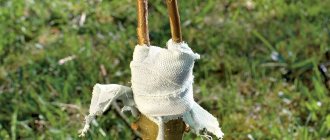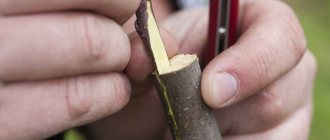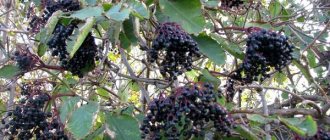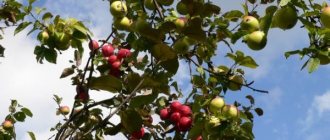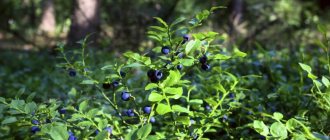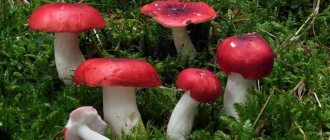What can be grafted onto bird cherry?
No matter how many varieties the breeders develop, the curious mind of the gardener requires vaccination. Moreover, it’s not enough to plant different varieties of the same species; you want to experiment! In this case, we will consider the interesting question of what can be grafted onto bird cherry.
Let's try to graft something onto the bird cherry tree
So, first, let's figure out why you are planning to get vaccinated in the first place. The fact is that if you really want to, you can graft a pine tree onto a birch tree, but why carry out such experiments? As a rule, people decide to graft something onto a bird cherry tree in several cases:
- the growth of this plant breaks all records and many weather difficulties are not afraid of it;
- this plant suffers almost no illnesses and withstands pest attacks;
- and finally, for cold regions this is another way to obtain a frost-resistant crop.
But can everything be vaccinated? The fact is that here a lot depends on the selection of the same time for the flowering and fruiting periods, the rate of bark growth, and many other factors. And not all interspecies and even intergeneric vaccinations turn out to be justified.
Many people have tried to graft cherry onto bird cherry, and it almost always ended in success. But again, don’t forget about the choice of plants. It is advisable to take only wild bird cherry, it is also called antipka, and select cherry varieties according to the timing of its flowering. In general, residents of cold regions usually try to graft cherries onto bird cherry trees; in other cases, it is much easier to take a young wild cherry seedling.
A very interesting question is whether it is possible to graft a plum onto a bird cherry, since both are stone fruits and success would seem to be guaranteed. In principle, it's worth a try, but the success is minimal. Almost certainly, the scion will take root well and will please the eye until the fall. But then the picture will be like this: first, the leaves on the scion will begin to turn yellow and fall off faster than usual, and
then they will even wither. The fact is that the plum needs enough nutrition and the scion simply will not receive it in the required quantity.
You can graft a pear onto a bird cherry, but such a graft will almost certainly grow quickly. In general, a pear is only friends with a pear; not even all varieties of apple trees will be a good rootstock for it. However, experienced gardeners claim that cuttings from a dying tree can be saved in this way. Until you find a worthy, full-fledged graft, the cutting can be temporarily grafted onto an antipka, and only then cut off a new one from the resulting shoots. It turns out that many species can be grafted onto bird cherry, but you will be able to get really good results when working with cherries.
womanadvice.ru
We get a high-quality harvest using cherry grafting
Every experienced gardener knows that thanks to grafting, you can quite quickly propagate any most desired variety. What is important is that with this method of propagation, the varieties will not lose their characteristic properties, which means you can save your favorite tree and improve its characteristics. The article contains information on how to plant cherries in your summer cottage. When is the best time to start the procedure and what technologies do you need to have for cherry grafting to be successful?
Compatibility
Trees, like all living things around us, grow, develop and age. And if you are thinking about how to extend the life of your favorite cherry tree, you can try grafting it onto a younger tree.
Cherry grafting begins with the need to prepare (grow) the rootstock. And only then graft the required variety. The plant you will be grafting on must meet certain criteria. It must be healthy, strong and, of course, a young tree. The thickness of its trunk is 3–10 cm. Strong branches of an adult viable tree with a diameter of at least 10 cm are also suitable.
Let's take a closer look at the issue of compatibility. There is a practice in gardening that the most successful and rational fusion will always occur only in individuals of one species. If grafting is carried out between varieties of the same name, then in this case the cutting will quickly take root.
If you don’t have stone fruit trees of this type at your summer cottage, or you want to experiment, then you can try the following options:
Grafting on plum
For almost all representatives of stone fruits, plum is the most successful and strong rootstock. If you decide to choose it in this capacity, it is advisable that the seedlings be semi-wild. Typically, such seedlings successfully adapt to the environment in a particular area and, importantly, are resistant to many diseases.
If we graft a felt cherry onto a plum tree, we will get a short (up to 3 meters) tree with a fairly wide crown, blooming in the spring with many pink and white flowers. And if you don’t know about the vaccine, you might think that in front of you is sakura.
Video “Grafting cherries onto plums”
This video will show you how to properly graft a cherry onto a plum.
Cherries
This type of fruit is also successfully used for grafting cherries, because these two berries are very similar to each other. Therefore, the fusion of the cuttings with the rootstock will take place quite quickly.
Cherry plum
Gardeners often use cherry plum for grafting. And this choice is very reasonable, since this is a fruit tree with a strong root system and has high frost resistance. And its seedlings are quite easy to get.
Turn
Grafting onto sloe (a relative of the plum) is also common. As a rule, such grafting is successful in most cases and therefore enjoys considerable popularity among amateur gardeners.
Bird cherry
The species is quite often used for rootstock. It is quite common, and the grafting process gives good results.
In most cases, cherries are perfectly grafted onto all of the above fruit trees, but there are exceptions. Remember that the main role in the grafting process is played by the rootstock.
When to vaccinate?
Cherry grafting occurs in spring and summer.
Grafting in the spring is considered the ideal choice. It is at this time that the process of sap flow occurs most actively and the cuttings we graft will easily and quickly take root.
If you did not carry out spring grafting or it was not successful, you still have a second chance and you can carry out budding in the summer. It is usually carried out from the second half of July to mid-August. At this time, the second sap flow takes place, and this will allow grafting to be carried out efficiently and successfully.
You should not vaccinate during the winter. At low temperatures, the tree slows down its metabolic processes and is in a state of rest. The likelihood that your cutting will take root is almost zero. However, there are exceptions when successful vaccination is also carried out during this period. Usually the rootstock is placed indoors, where it is not exposed to all the climatic changes that are characteristic of the winter period.
Vaccination methods
There are several methods of spring grafting, these include grafting into the cleft, behind the bark and improved copulation. Let's look at the situations in which each of them is used.
Into the cleft
If the thickness of the rootstock is much greater than the thickness of the cutting you are grafting, then you can graft into a split. To do this, the trunk of the rootstock should be cut with a sharp knife and split 3 cm deep. The cuttings are cut so as to obtain oblique cuts in the shape of a “sharp tongue”. This “tongue” must be placed so that their cambium layer and bark fit tightly together. For safety, use and place 2 clothespins (in case one does not take root). The grafting site is secured with a soft film.
Vaccination for bark
To carry it out, it is recommended to use 3–4 cuttings. The trimmed trunk of the rootstock is cleaned, and longitudinal cuts 3 cm long are carefully made on the bark with a special knife. Carefully moved away from the wood and cuttings are inserted with side cuts. The grafting site is wrapped with film for reliability. Using garden varnish, it is necessary to coat the grafted plants, making sure that the buds and upper edges are completely covered with varnish.
Copulation
If the thickness of the branches used for the scion and rootstock are the same, it is recommended to graft using the improved copulation method. To do this, you need to make oblique cuts 2-3 cm long on the trunk and handle. We also cut the upper edges of the cuts 1.5 cm deep. The resulting tongues of the scion and rootstock are positioned so that they fit into each other. Such grafting requires good support, otherwise the plant will not withstand a sharp or strong gust of wind and will break.
Kidney grafting - budding
In summer and autumn, cherries are grafted with buds (budding). This procedure begins in mid-July. A few days before grafting, the rootstock is prepared. It is thoroughly watered and the side shoots located at the bottom of the trunk are removed. If the cuttings were prepared in advance, they should be stored in the refrigerator or basement, wrapped in a damp cloth or sprinkled with damp sand. Better, the dormant bud will be cut from the tree exactly on the day of the procedure. Remove all the leaves on the cuttings, but the petioles should be left - they will be indicators by which we will determine whether the bud has taken root or whether the procedure needs to be repeated.
Using a budding knife, a part of the bark with a bud and leaf petiole is cut out from the cutting. On the trunk, 8–10 cm from the ground, the bark is cut, capturing the wood as well; the shield is also sharpened slightly and inserted into the cut on the trunk, combining the layers of wood and bark. Wrap tightly with grafting tape, leaving the petiole. If it disappears after a few days, the vaccination was a success. After 3-4 weeks, we remove the bandage, coat it with garden varnish, and in early spring we cut off part of the trunk above the grafted bud - now our bud is the main shoot.
Video “Cherry budding”
This video will show how to graft cherries using the budding method.
If you know how to plant cherries and the features of this process, then it will not seem like a difficult and difficult task. But be prepared for the fact that the procedure may fail the first time. However, constant practice, proper care, your desire and perseverance will help you rejuvenate your garden.
plodovie.ru
History of hybrid breeding
Before the hybrid was bred by I.V. Michurin, it has not been found in the wild. This scientist decided to crossbreed bird cherry and cherry. Numerous attempts have been made to cross-pollinate different plant species, but a successful attempt was the crossing of the Japanese Maaka bird cherry and the Ideal steppe cherry.
In this case, two types of hybrids were obtained:
- Bird cherry pollen was transferred to the cherry pistil. The resulting hybrid was named Cerapadus.
- The variety obtained when cherry pollen gets on the pistil of a bird cherry flower is called Padocerus.
The names chosen are related to the Latin names for bird cherry and cherry: Padus and Cerasus.
However, when creating hybrids at first, the new variety did not inherit all the important properties of its parents. It gained resistance to winter cold, a strong root system, and resistance to some diseases. However, the taste was not good enough. The berry harvest was large, but the fruits themselves were too small.
Later, from the first varieties of cerapadus, those that combined good taste, high yield, strong root system, winter hardiness and other advantages were obtained.
Scions and rootstocks of our gardens: what can be grafted onto what
Gardening is one of the most favorite pastimes of the people of our country. Of course, not everyone has enough land to do this on an industrial scale, but many can plant at least five trees.
How to speed up the onset of fruiting
Many people have a problem with the fact that domestic varieties often begin to bear fruit late. How to deal with this? The main method is the use of vaccinations. Traditionally, trees of the same species are used, although there are exceptions. So what can you vaccinate on?
Apple trees
First, let's look at apple trees, since they are the real queens of domestic gardens. If you do not have the opportunity to vaccinate against a certain cultural variety, do not despair. There are also wild apple trees!
For this purpose, you should choose young trees no older than 2-3 years. The main thing in this matter is to dig them out as carefully as possible, trying to preserve as much of the root system as possible. By the way, this rule can be broken: the tap root can and should be pruned, since such plants develop a more luxuriant crown.
But we don’t only have apple trees in our gardens! So what can you graft on in the case of pears?
Pears
There is a problem with wild trees of this species in domestic forests... But not everything is so bad!
If you have a low-value apple tree, you can graft a pear onto it. Practice shows that such “chimeras” become resistant to frost, begin to bear fruit earlier, and are less susceptible to pests and diseases. In the southern regions everything is much simpler. The same pear (like an apple tree) can be grafted onto cherry plum. Oddly enough, but the wild animals of this culture are simply an excellent basis for the formation of a cultivated tree.
Are there other options for what can be vaccinated against?
Nowadays it's the other way around...
Above we looked at where you can plant a pear cutting. What if we go the other way? So, what can you graft onto a pear?
If you read carefully, you will probably assume that you can graft an apple tree onto it. This is true, but there are much more interesting options!
There is a small peculiarity here. The fact is that trees of this species do not accept “strangers” well. Grafting other species onto them is the province of the most experienced gardeners, but any cultivated variety can easily be “planted” with a wild pear.
Cherry plum
Continuing the conversation about southern traditions, it is impossible not to mention cherry plum.
It is an ideal rootstock for all varieties. Apricots and peaches turn out simply gorgeous on it! Unfortunately, cherries and cherries will not take root on it. By the way, what can an apple tree be grafted onto in the conditions of our region?
Oh, there are dozens of options here! Empirically, it was found that quince (it will produce a dwarf form), serviceberry (it will also produce a dwarf form), and hawthorn are ideal as a rootstock. The result will be an exceptionally tall and cold-resistant tree. In addition, you can experiment with all types of mountain ash.
We hope that you have learned from us exactly what can be vaccinated for what. Please note that in many cases (when grafting onto trees of other species) the characteristics of the scion can be very different from those of the parent species.
fb.ru
Growing Cerapadus and Padocerus
Cerapadus and padocerus are still not very common in gardens as fruit crops. Not all gardeners like the taste of bird cherry in the pulp of the fruit. More often they are used as rootstocks for cherries, cherries, and plums.
Planting seedlings
Cerapadus seedlings should only be purchased at specialized sales points or directly at the nursery. Then you can be sure that you were sold the desired fruit crop and not a fake.
Cerapadus can be planted in early autumn or spring in April. The seedlings are quite frost-resistant and, when planted in autumn, will have time to take root before the onset of cold weather.
For planting cerapadus and padocerus, you can use any neutral soil with average fertility. The area should be sufficiently illuminated, without shading or drafts.
Planting holes for spring planting are prepared in the fall, and for spring planting - 2-3 weeks before planting the seedlings. To get a high annual yield, it is necessary to plant 2-3 seedlings, even if the variety is self-fertile. Sometimes, depending on weather conditions or the properties of the variety, partial self-fertility begins to predominate. As a result, many barren flowers appear during flowering, and the yield is noticeably reduced. During the first 2 years, the growth of cerapadus and padocerus seedlings may be slow, but then the plant makes up for lost time with rapid growth and the formation of root shoots, which can extend 2-3 meters away from the main plant.
Standard planting holes are prepared in advance, which are adjusted to the volume of the seedling’s root system before planting the crop. As a rule, Cerapadus and Padocerus seedlings have a powerful root system. The distance between plants in a row is 2.5-3.0 meters and between rows - up to 3.0-3.5 m.
Before planting, the cerapadus seedling is immersed in clean water or root solution for several hours. Prepare the soil mixture: 2 buckets of humus are mixed with 1 bucket of soil, add 100 g of potassium and phosphorus fertilizer or (which is simpler) 1 glass of nitrophoska. Mix well and pour into a tubercle-shaped hole. The root system of the seedling is straightened along the tubercle, half of the hole is sprinkled with soil, lightly compacted, and a bucket of warm (heated) water is poured out. After absorption, close the hole completely, add another 2-3 buckets of heated water and after it has been absorbed, generously mulch with fine mulch, possibly peat, sawdust (not pine), shavings, etc.
Cerapadus seedlings can be grown as a stand-alone crop, used as a high-quality rootstock, or used as a skeletonizer for multiple grafts on a single rootstock.
Ripe cerapadus fruits
Is it possible to graft something onto rowan and bird cherry?
They grow and are pleasing to the eye. Is it possible to plant something edible on them to make their stomach happy as well?
Irina, Bendery
Irina, you can try to graft a pear onto a rowan tree, but you just need to choose a variety so that the graft doesn’t come off due to the difference in growth. Grafts of plum apple trees take root well. I heard that hawthorn can be grafted, but I haven’t seen it myself. And my grandfather grafted cherries onto bird cherry trees. The grafting went well, and the cherries are still bearing fruit.
Irina, Nerekhta
Thank you, it’s interesting to try yourself as Michurin))))
Vasily, Kostroma
I grafted a pear, but nothing good came of it. The pear grew faster than the rowan. The graft fell off and broke off.
Natalya, Novorossiysk
Ir..., but bird cherry and rowan are considered inedible??! In the fall I planted THREE rowan trees and TWO bird cherry trees... For us this is exotic....
Inna Raevnikova, St. Petersburg
Some varieties of apple trees can be grafted onto rowan and hawthorn can be grafted.
Irina, Nerekhta
Edible... but not very much))
Gileva Valentina, Ust-Ilimsk
So let them grow like exotics - for beauty, they are beautiful in spring and autumn
Natalya, Novorossiysk
That’s why I planted it... Rowan trees are generally rare here... And I planted three whole things... True, only one wild one, I brought a seedling from Pskov :)) and I bought two garden ones from our nursery... And I planted red and black bird cherry (fig. knows what kind of bird cherry, but mom said plant it, it’s cool :))
Eleonora, Russia
You can graft bird cherry onto a rowan tree, and rowan onto a bird cherry tree))) I wonder what will happen)))))
Gileva Valentina, Ust-Ilimsk
When we have a rowan harvest, many people make wine from it, I tried the taste of Amaretto, sweet with a strong almond aroma. And this year I made compotes from bird cherry because there was a lot of it. so nothing. take a jar with you to the bathhouse, well, the birds are left for the winter
Sergey Kovalenko, Russia
Various varieties of cherries can be grafted onto bird cherry. Many people previously tried to graft pear onto rowan, it was believed that this way it would be more compact or even dwarf. This is partly true, but in fact, the pear often grows faster than the rootstock and can easily break off. Either under the weight of the crop, or simply under one’s own weight in severe bad weather. It will be a pity for the wasted time and effort.
Sergey Kovalenko, Russia
I forgot to ask, is it some kind of varietal rowan or ordinary wild one? It’s just that near Suzdal, or rather on the road to it from Vladimir, there grows some famous variety, the people of Suzdal are very suitable for it. They say it is larger and tastier than usual, and the liqueurs made from it are very tasty.
Irina, Nerekhta
Common, and there is a lot of growth around. I think maybe something will come out of it.
Natalya, Novorossiysk
Maybe NEZHINSKAYA, not NEVEZHINSKAYA :))))??!
Natalya, Novorossiysk
After all, she is NEVezhinskayaLast edited on January 16, 2016, 22:16
Tatiana, Sudislavl
Nightmare :))) I always thought that rowan, like cucumbers, is from Nezhin :)))
Natalya, Novorossiysk
Yes, Natasha, it is Nevezhinsky rowan. Here on our website several people paraphrased it, even in previous posts and comments. I am silent... This is exactly what they are proud of in Suzdal. In order for it to grow normally, for example, in my Kostroma, it must be grafted onto an ordinary rowan tree. I did this 10 years ago, when it dawned on me that she was not going to grow like in Opole. I have been making jam from it for two years in a row. And my liqueur plant is growing, it produces a lot of berries. Last edited on January 17, 2021, 14:40
Tatiana, Sudislavl
Tatyana, I understood why I was mistaken and why many are mistaken. The point is in the name of the alcoholic drink, which was made by Smirnov at the end of the 19th century - “Nizhyn Rowan”
This is what I found on the collectors forum -
“THE SECRET OF “NEZHINSKAYA ROWAN”
In 1889, the World Exhibition opened in Paris, to which Pyotr Smirnov brought not only liqueurs and vodkas already known to the whole world, but also a new drink, which later became the most famous in the family of Smirnov vodkas, “Nezhinskaya Rowan” (“Nezhinskaya Rowan” is one of the best and most popular drinks created at the plant near the Chugunny Bridge). It was she who conquered Paris, became the sensation of the exhibition and everyone’s favorite. French newspapers wrote about it as a Russian miracle, and experts were amazed at the unprecedented and exquisite aroma and taste. In addition, the jury was fascinated by the unusual shape of the bottle: an elongated cone, like a swan’s neck, and a corrugated “skirt” at the base. “Nezhinskaya” was so good that it immediately appeared on the covers of fashion magazines. It's a pleasure to drink and a pleasure to watch. And the shape of this bottle was invented by Pyotr Arsenievich himself, he loved to draw, and almost all the famous decanters and damasks were first born in his office.
The case in Paris ended as usual: “Nizhyn Rowan” was awarded the Big Gold Medal. Ryabinova's success both in Moscow and throughout Russia was complete. It instantly became so popular that the factory could not keep up with its production. Competitors became worried and began making rowan tinctures, rowan in cognac, and so on. But the opponents couldn’t do something as rowan as “Nezhinskaya”. Rowan is usually bitter, but Smirnov’s is sweet. Maybe he adds sugar? Or some kind of syrups? What's the secret? Maybe the rowan is special? They rushed to collect rowan trees near the city of Nezhin, but they were mistaken - they should have collected the wrong rowan tree there. But Pyotr Arsenievich foresaw all this and deliberately confused his competitors with the name.
And it was like this. Initially, “Nezhinskaya” was called “Nevezhinskaya”, because she came from the village of Nevezhina, in the Vladimir province, not far from Suzdal. The rowan here is truly special, there is nothing like it in the world. It is sweet, of different shades - from red and purple to yellow. Pyotr Smirnov knew a lot about herbs and berries from childhood, since Yaroslavl distillers and healers had long used them for vodka and medicinal potions. He himself and his vodka masters never worked blindly, at random, but attracted specialists, including scientists from Moscow University. Smirnov's people throughout European Russia were looking for raw materials for the production of special types of tinctures, liqueurs and vodkas. Pyotr Arsenievich knew where in the North it is best to collect juniper cones, where the most fragrant mint grows in the Moscow region, and where is lemon balm, and where is anise and coriander. Which swamps in the Novgorod province have the best cranberries. He had the best connections with the owners of distilleries and with merchants who sold bread. Therefore, it is no coincidence that the researcher’s curiosity once led him to the village of Nevezhino. It was in the fall of 1888, shortly after Pyotr Smirnov’s return from Spain, where in Barcelona his grape wines and vodkas received another gold medal, and Pyotr Arsenievich himself became a Knight of the Order of St. Isabella, bestowed upon him personally by the Spanish king for his outstanding contribution to industry.
That year the rowan tree was a great crop. Local peasants willingly made money by collecting half a ton of rowan bunches for a Moscow merchant. They were frozen and then put into action. The vodka turned out to be excellent, a box of which Pyotr Arsenievich sent to the Spanish king.
And then Smirnov realized: if he managed to make a tincture, others could too, especially since it’s not difficult to find the village of Nevezhino by its name. Therefore, he ordered to replace the name and redo the already prepared etiquette, explaining “So that others do not get carried away.” So instead of “Nevezhinskaya” the name “Nezhinskaya” appeared, more euphonious and romantic. And most importantly, it threw inquisitive competitors off the scent for many years.
The company stubbornly follows its motto - “to give the best, to produce products from first-class materials and to spare no expense and expense on improved production equipment.”
Juniper from the North, herbs from the Moscow region, cranberries from Valdai, rowan from near Suzdal - this was the embodiment of the motto “Give the best.” And this was the basis of the stunning diversity that amazed the assortment of drinks of P.A. Smirnov’s plant - from “Maraschino” to “Cherry Vodka”, from “Fine-Champagne” to “Nezhinskaya Rowan”, from the people’s favorite table wine No. 21 to liqueur "White plum", adored by the empress.
The story of the emergence of Nezhinskaya Rowan largely explains the reasons for the long-term success of P.A. Smirnov’s company, which has not given up its position for three decades.”…
And so on... I won’t quote the entire article... Last edited on January 17, 2021, 15:03
Natalya, Novorossiysk
Natasha, thanks for the excursion, but I know this... “Sorry!”
Irina, Nerekhta
And I’m not doing this for your development, but as an explanation of WHY I called the variety Nezhinsky :)
Natalya, Novorossiysk
Natasha, this is for mine)))) I didn’t know: RLast edited on January 17, 2021, 10:29 pm
Tatiana, Sudislavl
Well, wonderful, Ir :)) They even sold me this variety in the nursery, like Nezhinsky :)) I planted it, it’s a pity I didn’t leave a tag as a souvenir :)) So, I think there are enough people who confuse the names :))
Irina, Nerekhta
Natasha, we had a store called “Green City” and there was an area next to it where they buried what they didn’t sell, and so there these “Nezhinsky” ones stood next to them with tags. I asked the saleswoman: “Maybe Nevezhinskaya or another variety?” And in response: “What a difference!” This year the store died.))))
Tatiana, Sudislavl
I’ve been to Suzdal three times, but I didn’t know about rowan (((I’ll have to go again. I planted one young rowan. I bought it as a “nevezhinskaya” one. But there were no berries yet. What do they taste like?
Irina, Nerekhta
Irina, the berries seem to be the same in appearance. The clusters are larger, there are fewer spoiled berries, which are usually found in the forest. The taste is not tart, more sweet. Even without noticeable bitterness, the pulp is sweet, sour and juicy. The blackbirds are very absorbent, I barely managed to cover it with netting. They ripen in late August - early September. The berries themselves have an interesting shape, they are slightly elongated, pentagonal. But for jam, I blanched them, just like forest jam. In fact, I prefer not to eat jam, but to give it as a gift, and I really liked this. I made liqueurs from liqueur and chokeberry, but I regretted the Nevezhinskaya one. In Suzdal, this rowan can be tall - up to 8-10 m, but mine is grafted onto ours, now about 3 m. I was on an excursion from work in Suzdal in 1990. All of our people from the bus bought rowan at the market, then I asked, everyone said that either they bought the wrong thing, or the climate near Moscow was not for it. The taste is not the same. By the way, when I started pruning, it bore fruit better.
Eleonora, Russia
How good, I just trimmed it in the fall. I will wait for the harvest)))
Irina, Nerekhta
sourish-sweet, without the usual rowan bitterness and astringency. The birds peck them off before I have time to collect them, if I don’t protect them.
Boris, Shchekino
Here in the Vologda region Nevezhinskaya grows with its own roots, without any grafting.
Tatiana, Sudislavl
THIS IS PROBABLY ROWAN BERRY OR LIQUEUR BERRY-HYBRID WITH HAWTHORN (BOTH ARE VERY GOOD IN LIQUARIES)
Natalia Ivanova, Russia
you can try to graft similar crops onto them... something from stone fruits onto bird cherry... and onto rowan too... for example, I heard that you can graft melon onto pumpkin or zucchini, then the seeds from these melons will be more frost-resistant... i.e. If you graft a heat-loving plant onto bird cherry or rowan, it may turn out that it will become more resistant to the weather conditions of that area...
Irina, Nerekhta
I’m not sure that the zucchini root will give anything to the pumpkin seeds... some kind of telegony))) but you need to ask the experts.
A pear grafts well onto both red and black rowan (chokeberry). Rowan trees are more frost-resistant. The root system is different - it grows in areas with close groundwater - where the pear dies. But due to the difference in the development of rowan and pear, it is necessary to plant in one planting hole: a successfully grafted seedling and several more rowan seedlings. After a year or two, these additional (rootstocks) of rowan need to be grafted (like a “bridge”) onto the pear scion. This will give an increase in nutrition to the grafted pear, and most importantly, this “centipede” will give strength and stability to the PEAR TREE.
An apple tree is grafted onto rowan very well, especially if there is no wild game at hand. There was a lot of discussion on the site about vaccinations.
About 5-6 years ago, I grafted pear cuttings onto a regular red rowan, knowing that this is one of the options for a pear; it can also be used for aronia, but it often grows as a bush. We ate the first few pears the next year, and now every summer we gorge ourselves and treat our neighbors. I’ve been doing vaccinations for a long time, and this was my first experience. Of course, the pear grows wood faster, but it’s still growing and holding on. Nearby, half a meter away, there is a second rowan tree, from which I cut off all the branches from below so that they do not shade the pear grafting, from a distance it is not visible that these are 2 trees and it turns out that at the top there is a rowan tree crown, and under it there is a pear, passers-by are stunned by what a miracle has grown ))).
it turned out to be a funny neighborhood
7dach.ru
